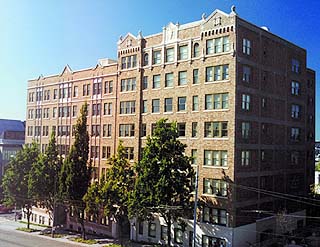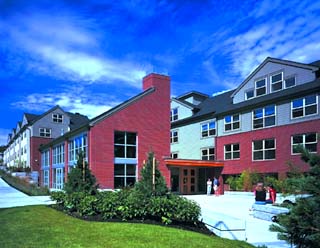
DJC.COM
September 26, 2002
Giving development the old college try
Lorig Associates

Photos courtesy of Lorig Associates Construction costs of renovating the Commodore Duchess Apartments at the UW were kept in check to ensure students could afford the rent. |
College campuses are often an integral part of the urban fabric, surrounded by and contributing to the residential, retail and commercial community. Faced with meeting their primary mission, the evolving demands of their students, campus planners are challenged with balancing the sometimes-disparate needs of the institution and the surrounding neighborhoods.
Like many other schools in urban settings, the University of Washington, Seattle University and Seattle Pacific University all recently undertook imaginative development projects that set examples of achieving that balance.
Unlike private projects, a college or university’s development is usually governed by its institutional master plan. The plan, typically authored by the institution with input from its surrounding community members, provides the framework for campus development and expansion. It reflects agreed upon mutual goals for campus development such as the maintenance of open space, the effective management of traffic and parking, and investing in and preserving high-quality buildings.
A key element of any master plan is the continued use of existing buildings. This involves periodic reviews of each building’s status to determine if renovations or upgrades are needed in order to meet current academic or residential needs.
The Commodore Duchess
One example of an effective renovation is the Commodore Duchess Apartments within the UW’s campus boundary. The Commodore Duchess housed students for more than 70 years, however its useful life had reached its limit when the building was closed in 1992.
The UW faced the challenge of wanting to renovate this historic building, while keeping construction costs balanced with the rental rates that students could afford. The building’s successful renovation was made possible through the use of experts in historic renovation from the private sector, plus the use of an innovative financing structure.
By extending the building’s useful life for many more decades, UW reintroduced 139 apartments back into its housing system, while adhering to its master plan goals and objectives.
Fitting in a law school
An institution’s academic goals can also trigger development challenges. In 1994 SU purchased the University of Puget Sound’s law school and integrated the program into its own existing operations. The resultant influx of hundreds of students and dozens of faculty members increased demand for parking beyond what the campus could accommodate. The city of Seattle required that SU meet this parking need by building 600 new parking spaces.
Seattle University’s location on First Hill and the high cost of land in that area made the construction of surface parking lots economically unfeasible. Building a structured parking garage could offset the high cost of the land, but how would SU build that many spaces close enough to campus, for an affordable price? The solution was to combine uses for the land by building housing for 300 students above the parking.
The Archbishop Thomas Murphy Apartments now anchor the south end of SU’s campus above the much-needed parking, providing the income needed to offset the cost of building a structured parking garage.
Seattle University faced a different development challenge when it launched its new Student Center project. The Student Center (which will officially open Oct. 2, 2002) along the north side of Cherry Street has been part of the school’s master plan for many years. The 60,000-square-foot facility provides a new focal point for the campus as it houses the school’s main food service, additional cafes, meeting rooms, lounges, and special areas, called collegium, for commuter students.
A major design challenge was how to provide for the safe passage of pedestrians across Cherry Street, a busy arterial connecting the surrounding neighborhoods with medical facilities and downtown, while not impeding vehicular traffic. The solution was to install a skybridge, which now links the Student Center with the Thomas Murphy Apartments. Skybridges have long been discouraged in other parts of town, but in this case it was the most reasonable solution, which met the competing need to ensure the safety of students while allaying the neighborhood’s concern about traffic flows.
Emerson Hall

Elements of SPU’s Emerson Hall were designed with a residential look to reflect the adjoining Queen Anne neighborhood. |
The proximity and integration of the SPU campus with its surrounding Queen Anne neighborhood has been a primary guiding principle during the recent expansion of its academic and housing facilities. In fall 2001, SPU opened Emerson Hall, which now houses 328 undergraduate students. In order to maximize the limited space available on the site and to minimize the traffic impact on narrow neighborhood streets, 139 parking spaces were tucked beneath the building in a structured parking garage.
In addition, many design elements of Emerson Hall were coordinated with the residential “feel” of the Queen Anne neighborhood. Extensive use of brick, beveled siding and stucco on the buildings helps blend it into the hillside, while maintaining its distinction as being unique to the SPU campus.
LEED standards
Another way that colleges and universities are being responsive to the needs of their urban surroundings is participation in the LEED (Leadership in Energy and Environmental Design) certification program. This nationwide program promotes sustainable development based on environmentally sensitive goals in design and material selection. LEED-certified projects acknowledge their role as a long-term member of the greater community and serve as examples for surrounding private development as well.
Blakeley Village Apartments, a new student residence under construction at UW, is an excellent example. The construction plans call for recycled content in its steel, concrete, drywall and finishes, and ultra-low-flow faucets and showerheads. Plus, a large pond on the site is being preserved as part of the development, instead of filling it in and maximizing the number of buildings. This makes the project environmentally sound while it creates a special ambience that contributes to the surrounding area.
As growing cities continue to put pressure on well-established campuses, colleges and universities will need innovative solutions to accommodate everything from technological advances to changing demographics. Campus master plans must be viewed with the same creativity as private urban development in order to remain viable.
Hal Ferris is a Lorig Associates partner with more than 20 years of experience in collegiate, commercial, industrial and mixed-use housing construction, construction management and development.
Other Stories:
- Bellevue faces its next stage of evolution
- 10 steps to safer city streets
- All aboard for Kent’s rebirth
- Renton rebounds with infill projects
- UrbanSim: Shaping metropolitan futures
- The urban redevelopment toolbox
- SoDo rezone pits industry against developers
- Lower Queen Anne goes Uptown
- Marketing urban homes in turbulent times
- Joe Average inks blueprints for downtown living
- Understanding history improves future of cities
- Building design — post 9/11
- Monorail elevates transit to a new low
- Condemnation: Whose property is it?
- Building infrastructure for urban vitality
- Urbanization demands better quality housing
- Tax-exempt bonds pump up nonprofit projects
Copyright ©2009 Seattle Daily Journal and DJC.COM.
Comments? Questions? Contact us.